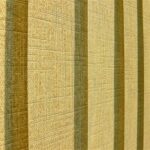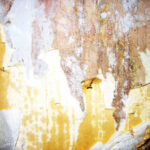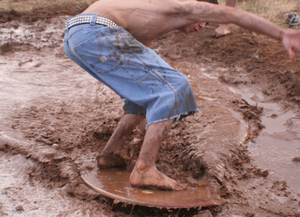The Victorian Era was the age of opulence. It seemed everyone in the new Middle Class was trying to show off wealth- even if they didn’t have it or couldn’t afford it.
Lincrusta was developed in 1887 as a less expensive alternative to raised and molded plaster wall reliefs and wainscoting. This substance is similar to linoleum and is expensive today.
Thomas J. Palmer invented an embossed wall covering in 1887 as a less expensive alternative. Made from wood fiber, cotton and other materials, this wallpaper is paintable and removable, should the homeowner desire to do so. Today, it remains an inexpensive alternative to pricier options.
Analgypta is available in vinyl and in wallpaper. Some products must be painted with oil-based paints while others should be painted with latex. Check the labels to be sure.
Installing it does take a bit of work, as does all wallpaper.
Prep work:
Clean the walls, repair any damages. If wallpaper exists, it must be removed first.
You will need:
• Your choice of anaglypta wallpaper. Buy more than you need for “oopsies,” tears, corners, etc.
• Straightedge
• Marker
• Level
• Utility Knife
• Adhesive for your specific product
• Latex paint or the type of paint for your product
• Brushes, rollers and general wallpaper and painting equipment
• Safety goggles and gloves
• Bucket, sponges and water
Step One:
Decide if you are going to install just a wainscot or to wallpaper the entire room, or just an accent wall. This will allow you to plan for the wall covering and materials.
The rule of thumb for wainscoting is no more than 1/3 of the wall’s height, usually about 32-36 inches. You can certainly make yours higher if you so desire.
Step Two:
Purchase your materials and study the instructions. There’s no contest to duplicate Lucy and Ethyl’s method of hanging wallpaper. (At least none that I know of.)
Now is the time to study your product. If you need to prep the pieces with water or adhesive, fold them glue side to glue side, as an accordion and allow them to sit for a few minutes, find out and allow time for this. Do not cut this step short.
For a wainscot, using the measuring tape, make a mark the height of your desired panel. Using the level, mark around the entire room. You’ll match this mark with each panel. Make plumb (straight horizontal marks) on the wall to ensure the panels hang straight. Plan now for corners. Using cardboard cut to the height and width of the panels is perfect for this.
Since anaglypta designs repeat on the sides, it’s easy to match the pattern at the top edge.
Step Three:
Do not apply glue to anything yet.
Begin at a corner or door molding. Make a plumb reference mark the width the panel and measure from the mark to the molding. If the door isn’t plumb, the covering will need to be trimmed. Match the widest mark, and make a second plumb line the panel’s width from that mark. Measure the other marks along one or two inch increments, and carefully transfer those marks to the panel. Make certain the factory edge is at the plumb line and the cut edge is against the molding.
Apply glue with the brush, and apply the panel to the wall, pressing at the level mark and at the molding. Using a soft roller brush, begin from the center and work outward to press into the wall to remove any air bubbles.
At the corners, trim off the excess and hang. Measure the width of the cut off piece and record it on a piece of paper. Hang a reference plumb line the width of the cut off piece and measure to the corner. Cut that much off the next panel and hang- the paper will match. If the corner isn’t plumb, cut as you did for the beginning piece. Since all the panels will be hanging straight, the eye won’t see a bowed or out of plumb corner.
Use a damp sponge to clean off any excess glue. Press the side seams firmly into the wall.
Cut excess off the top and bottom where you matched the pattern using the utility knife and a straight edge. Take care not to cut into the wall. Allow to dry for at least 24 hours.
For outlets and other fixtures, measure from the edge of the last panel to the outlet sides, and height. Transfer these markings to the next panel and cut out carefully.
Step Four:
Prime and paint the wall covering with the recommended type products. For an elegant Victorian look, paint the entire wall covering with one color, and using a lighter or different color, highlight the embossed or raised patterns.
Fill a paintbrush with just a little bit of paint and blot on a cloth until nearly dry. With a cleaning cloth in one hand and your almost empty brush in the other, lightly touch or brush the embossed patterns. Wipe any stray paint off with the clean brush. This adds a touch of elegance to the room.
You can paint the outlet coverings to match the wall, or the base coat. The eye won’t look for it, so it won’t be readily noticeable.
Step Five:
Install a chair rail and you’re done.
Notes to Consider:
• A note about choosing analgypta wall coverings- pay careful attention to the adhesive the specific product calls for. Some of the product must be attached with clay-based adhesive similar to installing lincrusta wall covering. That means beginning with a vinyl wallpaper liner attached to the wall first.
• Other types of analgypta call for regular, clear wallpaper adhesive. These do not need an additional surface attached to the walls. This will affect the total cost of the project.
• Want the look of a Victorian tin ceiling but can’t afford it? No problem- find a anaglypta pattern similar to your desire and install it on the ceiling. Paint it to resemble a tin ceiling. Only you know it’s not tin. I won’t tell.
• When it’s time to remove it, standard removal techniques will do the trick, unless you used the clay adhesive. Then it’s a little more work.
Your new walls look like you spent a fortune, but you didn’t. And you can be proud that you did it yourself. Invite friends over for a party to show off your new room.
Source: Staff Article: “Installing Anaglypta for Instant Elegance,” Decorator Secrets Website, no date given





